人教版(2019)必修 第二册Unit 4 History and traditions Lesson 1 Avatars课件(共41张PPT)
文档属性
| 名称 | 人教版(2019)必修 第二册Unit 4 History and traditions Lesson 1 Avatars课件(共41张PPT) |
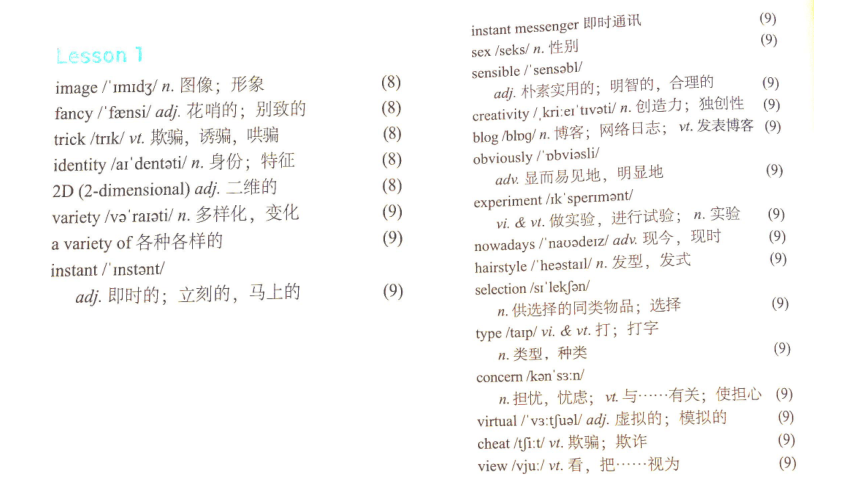
|
|
| 格式 | pptx | ||
| 文件大小 | 10.1MB | ||
| 资源类型 | 教案 | ||
| 版本资源 | 人教版(2019) | ||
| 科目 | 英语 | ||
| 更新时间 | 2023-05-28 11:00:47 | ||
图片预览

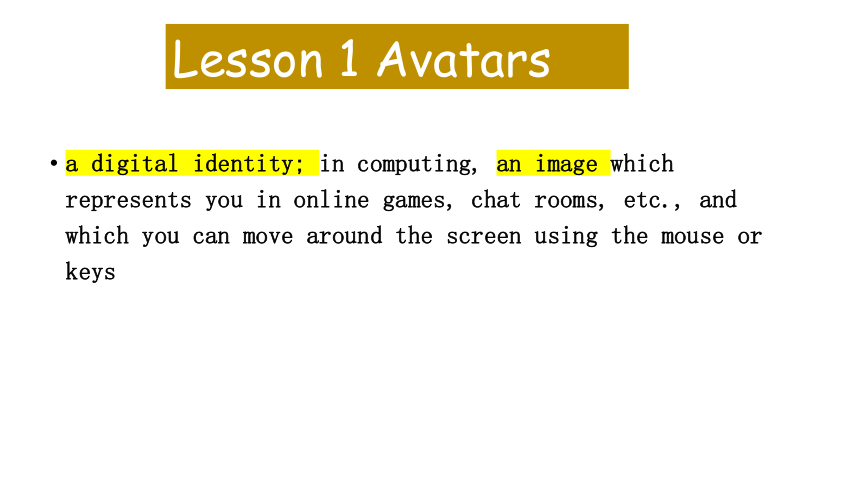
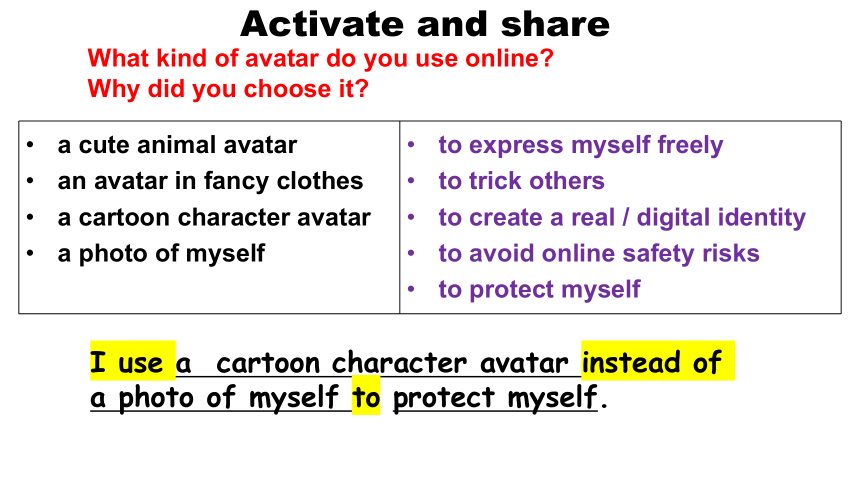
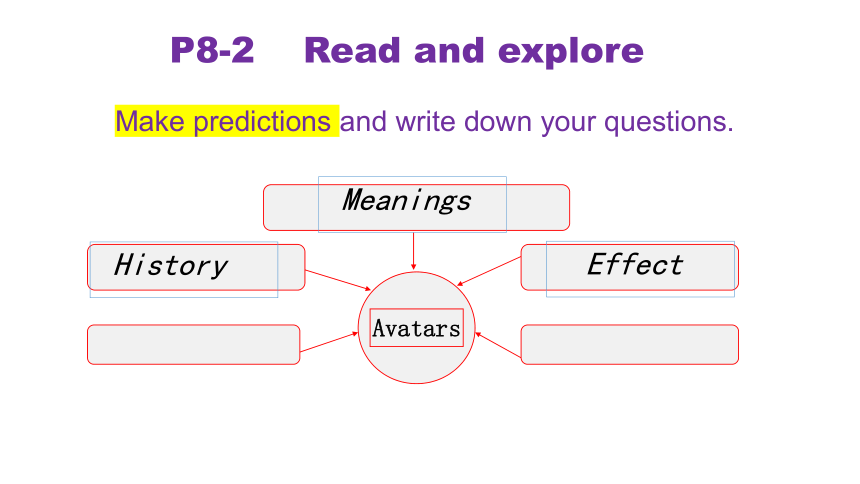

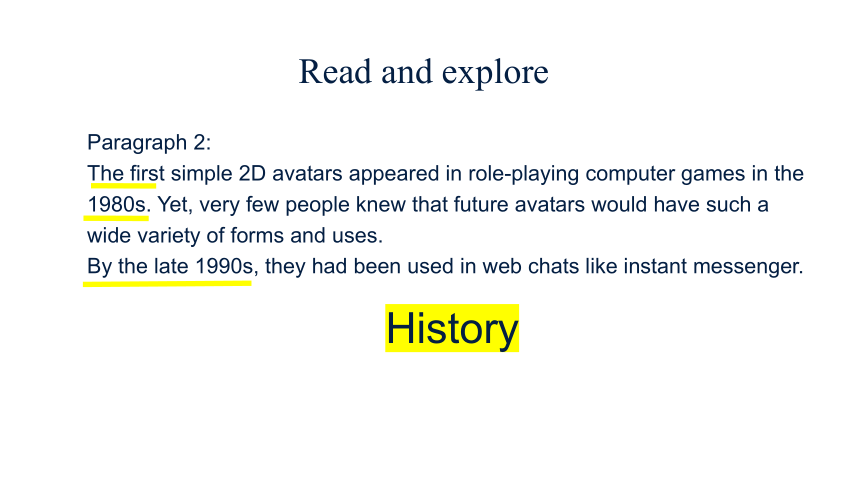
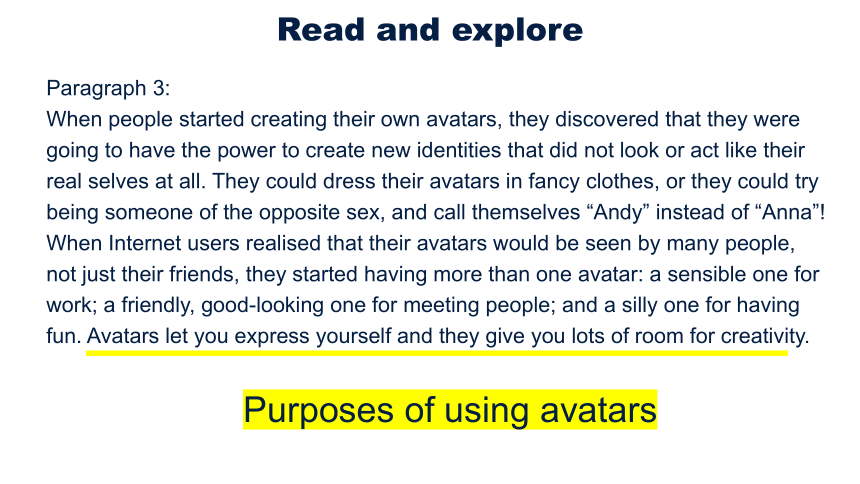
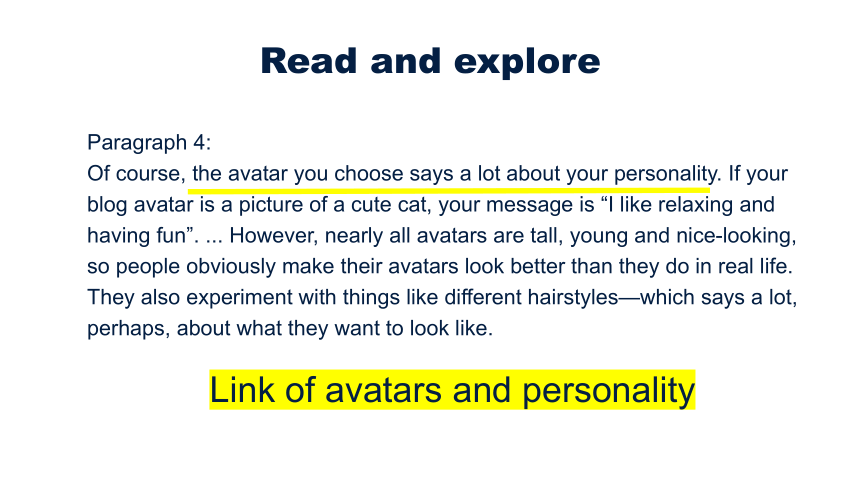
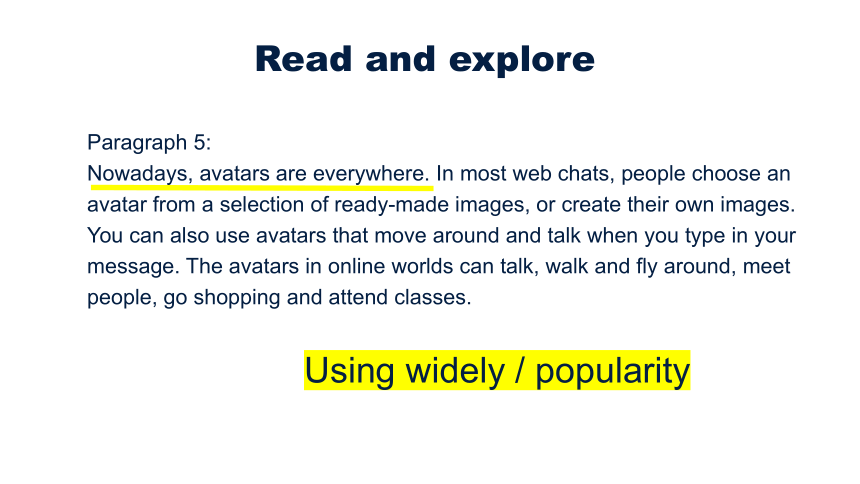

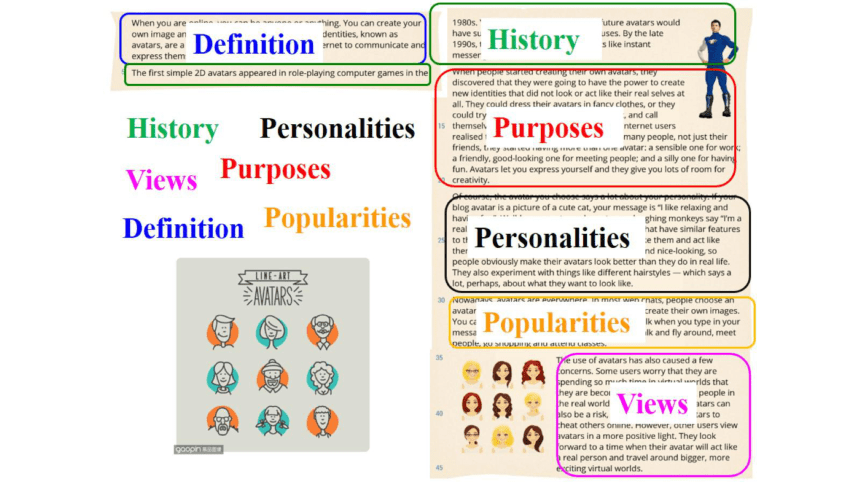
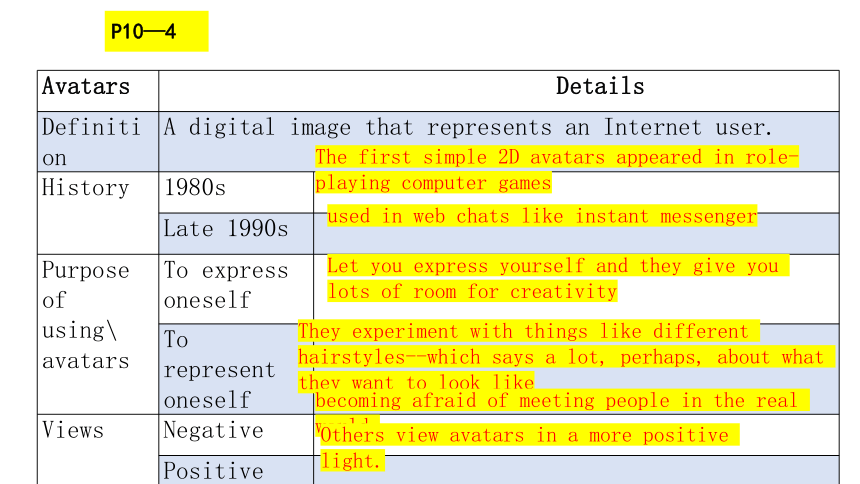
文档简介
(共41张PPT)
a digital identity; in computing, an image which represents you in online games, chat rooms, etc., and which you can move around the screen using the mouse or keys
Lesson 1 Avatars
a cute animal avatar an avatar in fancy clothes a cartoon character avatar a photo of myself to express myself freely
to trick others
to create a real / digital identity
to avoid online safety risks
to protect myself
Activate and share
What kind of avatar do you use online
Why did you choose it
I use a cartoon character avatar instead of a photo of myself to protect myself.
Make predictions and write down your questions.
Avatars
P8-2 Read and explore
Meanings
History
Effect
Paragraph 1:
When you are online, you can be anyone or anything. You can create your own image and a new personality. These digital identities, known as avatars, are a key part of how people use the Internet to communicate and express themselves.
Definition
Read and explore
Paragraph 2:
The first simple 2D avatars appeared in role-playing computer games in the 1980s. Yet, very few people knew that future avatars would have such a wide variety of forms and uses.
By the late 1990s, they had been used in web chats like instant messenger.
History
Read and explore
Paragraph 3:
When people started creating their own avatars, they discovered that they were going to have the power to create new identities that did not look or act like their real selves at all. They could dress their avatars in fancy clothes, or they could try being someone of the opposite sex, and call themselves “Andy” instead of “Anna”!
When Internet users realised that their avatars would be seen by many people, not just their friends, they started having more than one avatar: a sensible one for work; a friendly, good-looking one for meeting people; and a silly one for having fun. Avatars let you express yourself and they give you lots of room for creativity.
Read and explore
Purposes of using avatars
Paragraph 4:
Of course, the avatar you choose says a lot about your personality. If your blog avatar is a picture of a cute cat, your message is “I like relaxing and having fun”. ... However, nearly all avatars are tall, young and nice-looking, so people obviously make their avatars look better than they do in real life. They also experiment with things like different hairstyles—which says a lot, perhaps, about what they want to look like.
Link of avatars and personality
Read and explore
Paragraph 5:
Nowadays, avatars are everywhere. In most web chats, people choose an avatar from a selection of ready-made images, or create their own images. You can also use avatars that move around and talk when you type in your message. The avatars in online worlds can talk, walk and fly around, meet people, go shopping and attend classes.
Using widely / popularity
Read and explore
Paragraph 6:
The use of avatars has also caused a few concerns. Some users worry that they are spending so much time in virtual worlds that they are becoming afraid of meeting people in the real world. The use of several avatars can also be a risk, as people can use avatars to cheat others online. However, other users view avatars in a more positive light. They look forward to a time when their avatar will act like a real person and travel around bigger, more exciting virtual worlds.
Views / Concerns and hope
Read and explore
Avatars Details
Definition A digital image that represents an Internet user.
History 1980s
Late 1990s
Purpose of using\ avatars To express oneself
To represent oneself
Views Negative
Positive
The first simple 2D avatars appeared in role-playing computer games
used in web chats like instant messenger
Let you express yourself and they give you lots of room for creativity
They experiment with things like different hairstyles--which says a lot, perhaps, about what they want to look like
becoming afraid of meeting people in the real world.
Others view avatars in a more positive light.
P10—4
Q: What is the purpose目的 of the passage
To introduce the definition of avatars.
To express yourself using pictures.
To introduce the history of avatars.
To introduce some information about avatars.
Q: What is the text type of the passage
A. Narration (记叙文).
B. Argumentative Essay (议论文).
C. Expository Writing (说明文).
D. Practical Writing (应用文).
精确的
合理的
逻辑的
有说服力的
What does the writer mean by “the avatar you choose says a lot about your personality” Do you agree with the writer Give examples to support your opinion.
Think and share
Because most people create avatars that have similar features to their own and that look more or less like them and act like them. So I agree with the author. When I surf the Internet, I tend to create an avatar which is similar to myself in reality, even if there are slight differences between me and the avatar I created, the features, mostly with bright colors and happy faces are outgoing and interesting just like me.
2. Can you give examples of the risks of using avatars What can you do to prevent such risks
Think and share
Using avatars might lead to online frauds. For example, you go to a blind date and discover that the person you meet doesn't look like his avatar at all. Worse still, some may even fall for a cute avatar and transfer money to strangers easily.
To prevent such things from happening, I tend to chat with people I know in real life online only. Also, I would be very cautious if the online activity involves any transaction behavior.
Some tips to avoid online safety risks
Don’t expose your personal information to strangers.
Don’t expose your identity to strangers.
Stay alert when you are online.
Always take online safety at the first place.
identities
a selection
create your own images
room for creativity
express yourself
in virtual world
a risk
cheat others online
a more positive light
a few concerns
digital identities
variety
selection
image
personalities
chats
blogs
virtual
concerns
safety
page
personality
selection
images
character
creativity
fancy
hairstyles
source
P8
Para.1-2
Para.3
Para.4-5
Para.6
Grammar
P11—9 Read the sentences. Write P below the underlined parts that refer to the past and PF below the underlined parts that refer to the future in the past.
Yet, very few people knew that future avatars would have such a wide variety of forms and uses.
2. When people started creating their own avatars, they discovered that they were going to have the power to create new identities that did not look or act like real selves at all.
3. Many Internet users realised that their avatars would be seen by many people, not just their friends.
P
PF
P
PF
P
P
PF
The simple future tense
will / shall do
be going to do
be about to do
be doing
be to do
Grammar: Review
FORM USAGE
will/shall do
be going to do
be about to do
be doing
be to do
表示主语计划打算的行动或看来就要发生的事情
表示将来发生的动作或出现的状态, shall仅与第一人称连用
表示即将发生的动作,一般不带时间副词或短语
表示计划或安排好的动作(go, come, leave, begin等动词)
表示客观上计划或安排好的动作
The Usage of the Simple Future Tense
c He says that he won’t finish his work this afternoon.
d We are going to visit the Great Wall tomorrow.
a He said that he wouldn’t finish his work that afternoon.
b Last Sunday we were going to visit the Great Wall, but it rained.
Compare the following sentences
Past future tense
Group 1
Group 2
Something would happen in the future from a past point of view.
A
B
simple future tense
Something will happen in the future from a present point of view.
Past future
过去将来时
1. 概念
2. 结构及用法
3.形态
Grammar:
The Past Future Tense
( 过去将来时)
01
过去将来时表示从过去某一时间来看,将要发生的动作或存在的状态。
02
过去将来时常用在主句谓语动词为过去时态的宾语从句/间接引语/虚拟语气中。
03
过去将来时句子中有时包含时间状语 the next day,the following week,soon等。
shall/will do
be going to do
be to do
be about to do
be doing
Past future tense 过去将来时
would/should do
was/were going to do
was/were to do
was/were about to do
was/were doing
1. would/should + 动词原形,常表示根据计划或安排即将发生的事。
should主要用于主语是第一人称时;would可用于各种人称。
(1) He said he would go to the cinema tonight.
(2) Mary told me she would go abroad the next year.
(3) I said I should learn French this year.
结构及用法
2. was/were going to + 动词原形,也可表示根据计划或安排即将发生的事。
No one knew when he was going to come.
(2)She said she was going to set off at once.
(3) I was told that he was going to return home.
3. was/were to + 动词原形,按照约定或按职责义务要求必须做某事。
He said he was to arrange his holiday with his older brother in a week.
4. was/were about to + 动词原形,
表示即将要发生的动作, 不与表示时间段的状语连用。
(1) The bus was about to start.
(2) Colin was about to get off the camel when a child ran towards him.
5. was/ were on the point of doing:表示 “正要……时”。
He was on the point of saying something when the phone rang.
6. come, go, leave, arrive等动词可用过去进行时代替过去将来时。
7. 条件状语从句和时间状语从句中的动词须用一般过去时代替过去将来时。
(1) He said the train was leaving at six the next morning.
(2) She told me she was coming to see me.
(1) I didn't know when she would come, but when she came I would let you know.
(2) The teacher said that it would be very difficult to make progress if I didn’t work hard.
a digital identity; in computing, an image which represents you in online games, chat rooms, etc., and which you can move around the screen using the mouse or keys
Lesson 1 Avatars
a cute animal avatar an avatar in fancy clothes a cartoon character avatar a photo of myself to express myself freely
to trick others
to create a real / digital identity
to avoid online safety risks
to protect myself
Activate and share
What kind of avatar do you use online
Why did you choose it
I use a cartoon character avatar instead of a photo of myself to protect myself.
Make predictions and write down your questions.
Avatars
P8-2 Read and explore
Meanings
History
Effect
Paragraph 1:
When you are online, you can be anyone or anything. You can create your own image and a new personality. These digital identities, known as avatars, are a key part of how people use the Internet to communicate and express themselves.
Definition
Read and explore
Paragraph 2:
The first simple 2D avatars appeared in role-playing computer games in the 1980s. Yet, very few people knew that future avatars would have such a wide variety of forms and uses.
By the late 1990s, they had been used in web chats like instant messenger.
History
Read and explore
Paragraph 3:
When people started creating their own avatars, they discovered that they were going to have the power to create new identities that did not look or act like their real selves at all. They could dress their avatars in fancy clothes, or they could try being someone of the opposite sex, and call themselves “Andy” instead of “Anna”!
When Internet users realised that their avatars would be seen by many people, not just their friends, they started having more than one avatar: a sensible one for work; a friendly, good-looking one for meeting people; and a silly one for having fun. Avatars let you express yourself and they give you lots of room for creativity.
Read and explore
Purposes of using avatars
Paragraph 4:
Of course, the avatar you choose says a lot about your personality. If your blog avatar is a picture of a cute cat, your message is “I like relaxing and having fun”. ... However, nearly all avatars are tall, young and nice-looking, so people obviously make their avatars look better than they do in real life. They also experiment with things like different hairstyles—which says a lot, perhaps, about what they want to look like.
Link of avatars and personality
Read and explore
Paragraph 5:
Nowadays, avatars are everywhere. In most web chats, people choose an avatar from a selection of ready-made images, or create their own images. You can also use avatars that move around and talk when you type in your message. The avatars in online worlds can talk, walk and fly around, meet people, go shopping and attend classes.
Using widely / popularity
Read and explore
Paragraph 6:
The use of avatars has also caused a few concerns. Some users worry that they are spending so much time in virtual worlds that they are becoming afraid of meeting people in the real world. The use of several avatars can also be a risk, as people can use avatars to cheat others online. However, other users view avatars in a more positive light. They look forward to a time when their avatar will act like a real person and travel around bigger, more exciting virtual worlds.
Views / Concerns and hope
Read and explore
Avatars Details
Definition A digital image that represents an Internet user.
History 1980s
Late 1990s
Purpose of using\ avatars To express oneself
To represent oneself
Views Negative
Positive
The first simple 2D avatars appeared in role-playing computer games
used in web chats like instant messenger
Let you express yourself and they give you lots of room for creativity
They experiment with things like different hairstyles--which says a lot, perhaps, about what they want to look like
becoming afraid of meeting people in the real world.
Others view avatars in a more positive light.
P10—4
Q: What is the purpose目的 of the passage
To introduce the definition of avatars.
To express yourself using pictures.
To introduce the history of avatars.
To introduce some information about avatars.
Q: What is the text type of the passage
A. Narration (记叙文).
B. Argumentative Essay (议论文).
C. Expository Writing (说明文).
D. Practical Writing (应用文).
精确的
合理的
逻辑的
有说服力的
What does the writer mean by “the avatar you choose says a lot about your personality” Do you agree with the writer Give examples to support your opinion.
Think and share
Because most people create avatars that have similar features to their own and that look more or less like them and act like them. So I agree with the author. When I surf the Internet, I tend to create an avatar which is similar to myself in reality, even if there are slight differences between me and the avatar I created, the features, mostly with bright colors and happy faces are outgoing and interesting just like me.
2. Can you give examples of the risks of using avatars What can you do to prevent such risks
Think and share
Using avatars might lead to online frauds. For example, you go to a blind date and discover that the person you meet doesn't look like his avatar at all. Worse still, some may even fall for a cute avatar and transfer money to strangers easily.
To prevent such things from happening, I tend to chat with people I know in real life online only. Also, I would be very cautious if the online activity involves any transaction behavior.
Some tips to avoid online safety risks
Don’t expose your personal information to strangers.
Don’t expose your identity to strangers.
Stay alert when you are online.
Always take online safety at the first place.
identities
a selection
create your own images
room for creativity
express yourself
in virtual world
a risk
cheat others online
a more positive light
a few concerns
digital identities
variety
selection
image
personalities
chats
blogs
virtual
concerns
safety
page
personality
selection
images
character
creativity
fancy
hairstyles
source
P8
Para.1-2
Para.3
Para.4-5
Para.6
Grammar
P11—9 Read the sentences. Write P below the underlined parts that refer to the past and PF below the underlined parts that refer to the future in the past.
Yet, very few people knew that future avatars would have such a wide variety of forms and uses.
2. When people started creating their own avatars, they discovered that they were going to have the power to create new identities that did not look or act like real selves at all.
3. Many Internet users realised that their avatars would be seen by many people, not just their friends.
P
PF
P
PF
P
P
PF
The simple future tense
will / shall do
be going to do
be about to do
be doing
be to do
Grammar: Review
FORM USAGE
will/shall do
be going to do
be about to do
be doing
be to do
表示主语计划打算的行动或看来就要发生的事情
表示将来发生的动作或出现的状态, shall仅与第一人称连用
表示即将发生的动作,一般不带时间副词或短语
表示计划或安排好的动作(go, come, leave, begin等动词)
表示客观上计划或安排好的动作
The Usage of the Simple Future Tense
c He says that he won’t finish his work this afternoon.
d We are going to visit the Great Wall tomorrow.
a He said that he wouldn’t finish his work that afternoon.
b Last Sunday we were going to visit the Great Wall, but it rained.
Compare the following sentences
Past future tense
Group 1
Group 2
Something would happen in the future from a past point of view.
A
B
simple future tense
Something will happen in the future from a present point of view.
Past future
过去将来时
1. 概念
2. 结构及用法
3.形态
Grammar:
The Past Future Tense
( 过去将来时)
01
过去将来时表示从过去某一时间来看,将要发生的动作或存在的状态。
02
过去将来时常用在主句谓语动词为过去时态的宾语从句/间接引语/虚拟语气中。
03
过去将来时句子中有时包含时间状语 the next day,the following week,soon等。
shall/will do
be going to do
be to do
be about to do
be doing
Past future tense 过去将来时
would/should do
was/were going to do
was/were to do
was/were about to do
was/were doing
1. would/should + 动词原形,常表示根据计划或安排即将发生的事。
should主要用于主语是第一人称时;would可用于各种人称。
(1) He said he would go to the cinema tonight.
(2) Mary told me she would go abroad the next year.
(3) I said I should learn French this year.
结构及用法
2. was/were going to + 动词原形,也可表示根据计划或安排即将发生的事。
No one knew when he was going to come.
(2)She said she was going to set off at once.
(3) I was told that he was going to return home.
3. was/were to + 动词原形,按照约定或按职责义务要求必须做某事。
He said he was to arrange his holiday with his older brother in a week.
4. was/were about to + 动词原形,
表示即将要发生的动作, 不与表示时间段的状语连用。
(1) The bus was about to start.
(2) Colin was about to get off the camel when a child ran towards him.
5. was/ were on the point of doing:表示 “正要……时”。
He was on the point of saying something when the phone rang.
6. come, go, leave, arrive等动词可用过去进行时代替过去将来时。
7. 条件状语从句和时间状语从句中的动词须用一般过去时代替过去将来时。
(1) He said the train was leaving at six the next morning.
(2) She told me she was coming to see me.
(1) I didn't know when she would come, but when she came I would let you know.
(2) The teacher said that it would be very difficult to make progress if I didn’t work hard.
